Super Mario Land
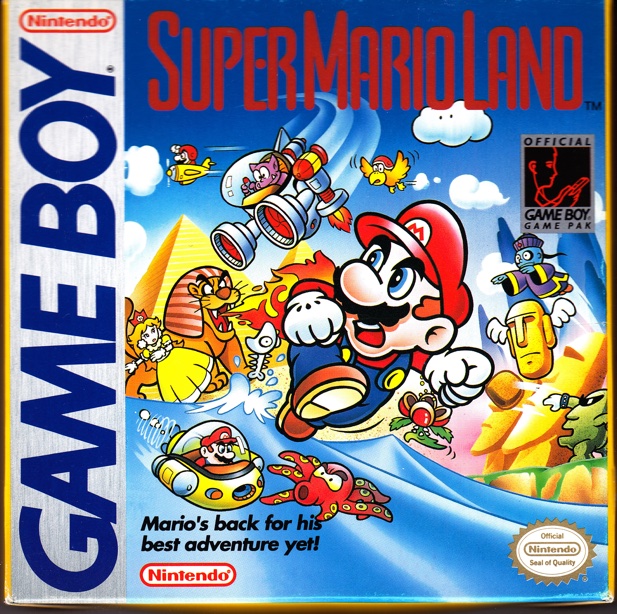
- Japanese release in April 1989
- North American release in July 1989
- European release in September 1990
- European release in 1990
- Australian release in 1990
- Asian release in 1990
- Brazilian release in 1993
- North American release in May 1996
- European release in 1996
- Game Boy Nintendo Classics
- North American release in November 1999
- Japanese release in March 2000
- Developed by Nintendo
2-Bit Mario

Super Mario Land is a technological dead end with its roots in the Game & Watch portables of the 80s. Featuring design decisions that were abandoned by almost all Game Boy developers, Super Mario Land is nonetheless essential because it is the first game ever made for Game Boy.
Made by Gunpei Yokoi and his team at R&D1, without Super Mario Land there simply is no Game Boy. The game was meant to prove that you could have platform games be as fun as what Nintendo was doing on NES. On that front it succeeded but it’s also an interesting example of a strategic pivot by Nintendo. Once they discovered Tetris, Nintendo sidelined this Mario game and bet heavily that the Game Boy and Tetris were a better story to sell to potential players. Their proof-of-concept Mario game could not sell the Game Boy to as many people as the falling blocks of Tetris. Of course, they released this game and marketed it heavily but in markets where they advertised and sold bundles on release the Game Boy came with Tetris, not Super Mario Land. Nintendo worked hard to equate Game Boy with Tetris. Working from Tetris’ success as this vanguard from the system, Game Boy developers knew what to copy when they made puzzle games. Platform games on Game Boy had to pave another path to success; Super Mario Land’s ideas were not easily marketable.
A Tiny Slice of History
Research & Development 1, Yokoi’s division within Nintendo, was riding high at the end of the 80s. The Game & Watch portable first introduced in 1980 were still successful in 1989. Using the popularity of the new franchises created by Shigeru Miyamoto for the Famicom, Multi Screen games like Zelda featured maps, items, progression, continues, even bosses.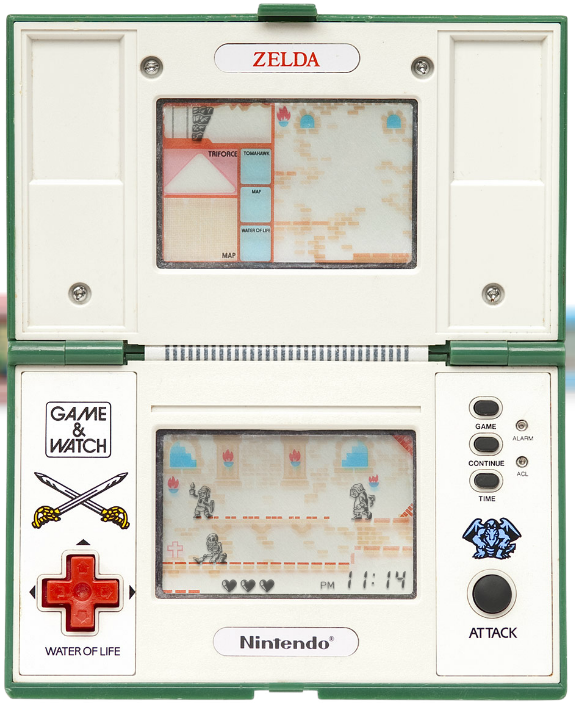 The Zelda Game & Watch
The Zelda Game & Watch
They basically tried everything they could to make the Game & Watch games feel as expansive as they could, recreating the best Nintendo games of the Famicom and NES on tiny tailor-made calculator screens. At this point I kind of have to explain what the Game & Watch titles were. Game & Watch games used black and white LCD screens with pre-defined LCD graphics permanently imprinted on the screen. Just like a calculator can only display little shapes that add up to show numbers the Game & Watch used the same screen technology but with intricately drawn characters. Those discrete elements cannot move around the screen just like the characters on a calculator display can’t start jumping around. This means you have to be very inventive with your game design to imply movement and action. Add to that silkscreened overlays for background elements and you have dedicated portable systems with loads of charm and the ability to display a clock (hence the title Game & Watch). Those little portables were more toys than video games, however, obviously limited to one game per little machine. Many companies ultimately copied Nintendo’s design, making the LCD single game concept pioneered by Nintendo synonymous with portable gaming in the 80s. However, Nintendo saw a terrible future for the Game & Watch family. A black cloud was hanging over the market of single-game LCD portables.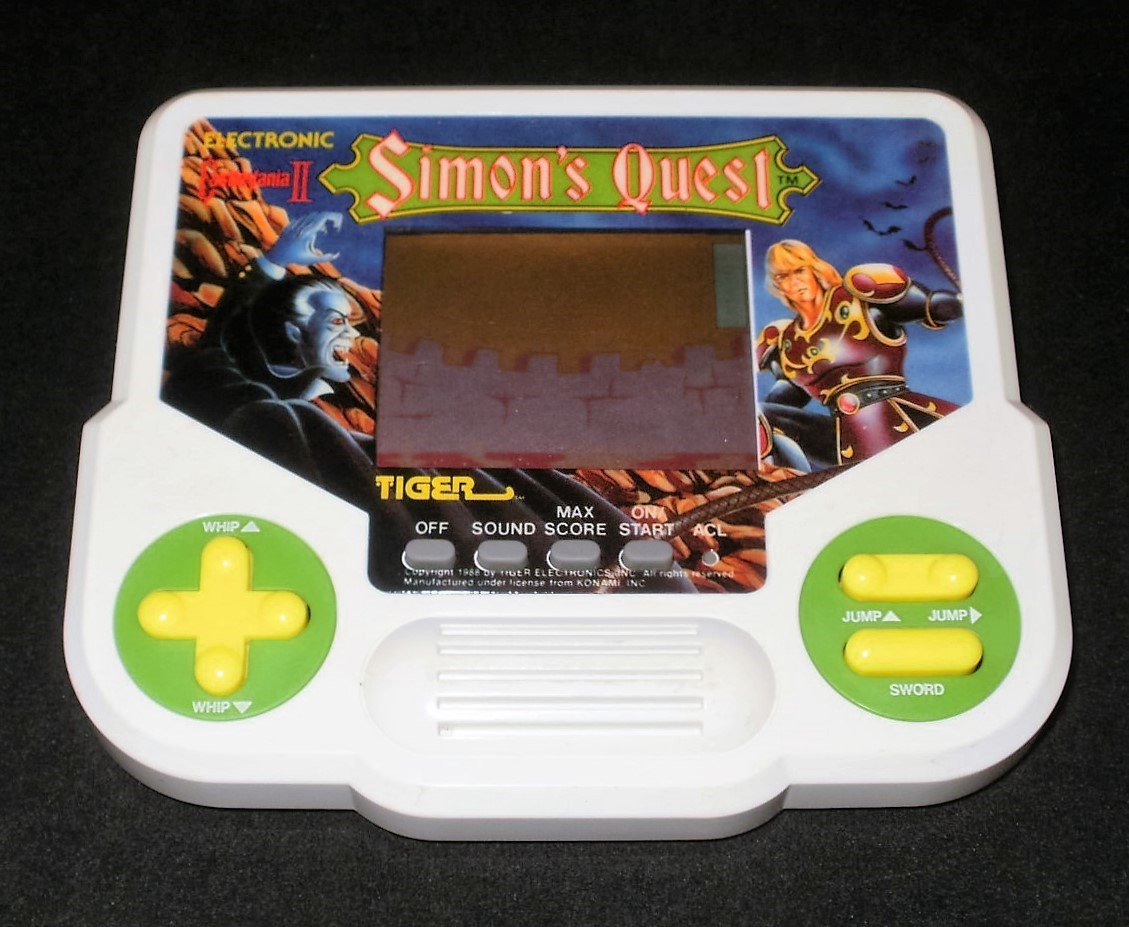
Sidenote
When Nintendo abandoned the Game & Watch concept in 1991 Tiger Electronics was by then the king of the LCD games. Starting in 1988, they had managed to reduce production costs to oblivion and had flooded the market with crappy licensed games of everything under the sun. In time, this included old franchises like The Flintstones, popular movies like Batman Returns and Jurassic Park, blockbuster arcade titles like Street Fighter II or Mortal Kombat and corny 80s sitcoms like Full House. I kid you not there even was a MC Hammer LCD game. As someone born in 1986, I never laid hands on a Game & Watch but by the middle of the 90s I can attest that Tiger Electronics games were everywhere.
The larger ones were cheap, the smaller ones came with other toys and I even remember getting a Tiger Electronics watch of the Pagemaster movie in a cereal box! They all had one point in common though: they were terrible games with brain-dead gameplay. By then Nintendo had wisely moved on. If like me you have only played the Tiger Electronics LCD games, try a Nintendo Game & Watch title. They’re on a completely different order of magnitude. A great way to play them is with the Game & Watch games on Game Boy. That’s how I first discovered them.
Dot Matrix Gameplay
Back in the 80s Yokoi and the people at R&D1 were putting a lot of efforts into their LCD games (it showed) but they were probably itching for a richer experience, desiring to allow their customers to play games as complex as the Famicom titles that Miyamoto’s team at R&D4 were making (R&D4 was renamed Entertainment Analysis & Development [EAD] in 1989, as all of this was happening). R&D1 was originally tasked with creating Nintendo’s arcade titles but when that fizzled away, R&D1 pivoted hard to the Game & Watch titles. When the time came to move ahead with a new concept, Yokoi’s strategy came in handy. He was always trying to find new ways to use seasoned technology; he described it as Lateral Thinking of Withered Technology. What does that mean? Using cheap, simple technologies that you know very well in interesting ways. Developments in the early 80s, which fit in that exact mindset, allowed for inexpensive low-power monochrome pixel displays called super-twisted nematic LCDs. Those displays had very interesting qualities over standard TFT LCDs (TFT LCDs are what you would find in the Game Gear, the Atari Lynx and laptops of the time). This all fell in line with Yokoi’s hardware strategy; STN LCDs were cheap to produce, very energy-efficient compared to TFT LCDs, and they used pixels instead of the discrete crystals of the Game & Watch. This is why the Game Boy proudly proclaimed itself a Dot Matrix with Stereo Sound above the screen: R&D1 is saying they’re proud because its screen is made with pixels. This meant that you could display anything you could program. The fact that the screen ended up pea-soup green, monochrome and with very pronounced ghosting were all side effects Yokoi was ultimately willing to live with in exchange for great battery life and an affordable cost.
Slap a weird mix between a Z80 and an Intel 8080 made by Sharp in there (another cheap technology that was very well understood in the 80s), add the controls of the NES (Yokoi had previously invented the D-pad with the Game & Watch) and you’re all set. Surprisingly, recent interviews with Satoru Okada, who worked directly under Gunpei Yokoi have shown that the main man was not necessarily on board with the idea of the Game Boy as a portable NES. Okada claims that Yokoi instead wanted something cheaper and more similar to the Game & Watch line, a better MB Microvision in a sense. Okada basically built the Game Boy without Yokoi’s direct involvement. You could argue that to convince the naysayers, R&D1 needed a proof-of-concept; a way to show people what their new thing was capable of. For the Game Boy, that was Super Mario Land.
Sarasaland
We’ve talked extensively about the history that led to Super Mario Land, but how does the game play? The first thing to keep in mind is that no other game is quite like it. While the overwhelming majority of platform games on Game Boy features sprites who have the same pixel count as their NES counterparts, Super Mario Land chose to use a proportional perspective.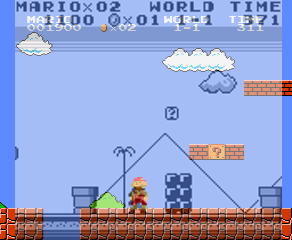 Super Mario Land superimposed over Super Mario Bros. You can see how the space ahead of Mario is very similar.
Super Mario Land superimposed over Super Mario Bros. You can see how the space ahead of Mario is very similar.
Both Super Mario Bros. and Super Mario Land share the same overall proportions on the screen. Even though one is on a standard NTSC TV screen with a generous resolution and the other is on the limited Game Boy screen Mario has the same amount of ground in front of him in both games. To achieve such a large field of play on Game Boy the sprites are ultimately minuscule. If you compare the sprites of Mario & Wario on all of their Game Boy games you will understand what I mean by minuscule. The only other game I know that uses sprites this small for a platform game is Batman: The Video Game. If you know any other one with similar proportions on Game Boy, let me know! Sprites from all the Mario & Wario games on Game Boy. Mario’s head in Super Mario Land is smaller than Wario’s butt!
Sprites from all the Mario & Wario games on Game Boy. Mario’s head in Super Mario Land is smaller than Wario’s butt!
That initial decision to keep the same overall proportions as on NES means the gameplay is unique. The scenery runs by very fast compared to other games on Game Boy and the jumps are enormous. The screen never scrolls up or down; the only direction the screen ever goes is right, just like Super Mario Bros. on NES. With so large a play field there is a truly rare sight on Game Boy; levels have distinct upper and lower passages on the same level without any upward or downward scrolling.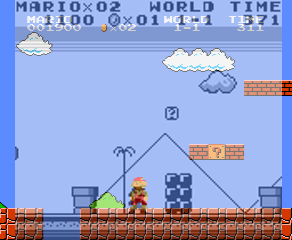 You can go above or under without any vertical scrolling. Unbelievable, but this is absurdly rare on Game Boy.
You can go above or under without any vertical scrolling. Unbelievable, but this is absurdly rare on Game Boy.
Super Mario Land, as we’ve established, came out of a studio that was used to making Game & Watch games. It shows. The most potent examples to me are the weird walking UFO enemies in the second world. They’re made of two distinct separate parts. When you jump on the enemy it loses its top part and keeps milling about with its bottom part. Since neither part touch, you would not be mistaken to think this hamburger of an enemy would be made of two LCD crystals like on a Game & Watch.
This, to me, is the most potent example of something clear with Super Mario Land: it was built by a team renown for their Game & Watch games. The way the turtle shells explode when hit, the backgrounds, the way enemies lose non-overlapping parts of their body when you first hit them. I can’t find any information that the two designers, Hirofumi Matsuoka and Masahiko Mashimo, were Game & Watch designers but it sure does look like Super Mario Land’s graphic designers kind of forgot they could have overlapping and interlocking elements.
SMB for DMG
Since the game is so clearly meant to emulate Super Mario Bros. how does it compare? Not that favourably to be honest. Mario does not control as well as on NES, having short momentum and limited control on diagonal jumps. This is the game’s biggest sin; usually when one thinks of a Mario game one thinks of flawless controls. This is not the case here. They’re not perfect and it hurts the game’s enjoyment. On the other hand, the checkpoints are generous and the game is not stingy on the extra lives. The game is not frustrating. I’d say it’s much easier than Super Mario Bros. .
Levels and Length
Super Mario Land did one thing that everybody immediately copied: its length. It codified how long a game on Game Boy should be with its twelve levels instead of the thirty-two of Super Mario Bros. on NES. Ultimately you get around a third the content as Super Mario Bros. and a lot of Game Boy games will follow that general rule that it first established. It will take years to start finding original games that are as long as console games on Game Boy.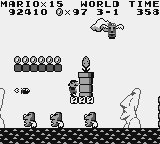 Super Mario Land features two shooter levels. The last level, with the last boss, is even one of them. They’re nothing to write home about.
Super Mario Land features two shooter levels. The last level, with the last boss, is even one of them. They’re nothing to write home about.
The levels are also not as interesting and memorable as on NES. Even though the building blocks are more varied and the enemies truly weird the levels are sparsely populated (they were probably very careful with enemy placement due to the poor screen) and the obstacles are not that inspired. Interestingly, the game separates its twelve levels in four distinct worlds with very clear real-world analogues.
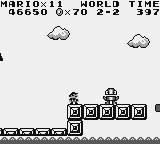 Egypt
Egypt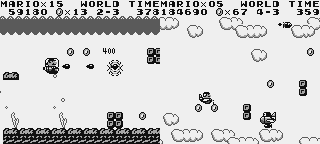 The Bermuda Triangle
The Bermuda Triangle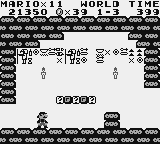 Easter island
Easter island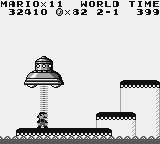 China
ChinaThis is another aspect of Mario that is not traditional. When one thinks of the setting of Mario games you think of blocks, tunnels, castles, anything but adaptations of real-world locations. Super Mario Bros. 3 is all Piranha plants and pipes, not anything realistic. I mean there are pyramids but they don’t have any Egyptian hieroglyphs or mummies. The exception to the rule is Super Mario Bros. 2 with its very clear Arabian influence but that was originally another game based on a Japanese festival that was influenced by One Thousand and One Nights. I’ve read rumours that Super Mario Land was originally not a Mario game and got turned into one during development. All its off-key weird levels including the side-scrolling shooter levels might make you think that. Seriously, who thought of dumping Mario in a submarine? A prop plane? Why does Mario start World 2 coming out of a flying saucer? Whatever the case may be, the most important thing to keep in mind is Super Mario Land was not made by Mario’s father, Miyamoto and his team, but by Yokoi’s team. To me that’s enough explanation for why the controls and the levels are weird. Everything about this game is off-key. It’s a cavalcade of weird enemies and bosses.
But it’s all off-key in hindsight. Mario games are a very codified franchise now but that wasn’t the case back in 1989 when this game was made and released. So that’s why it’s so essential. It’s a weird side step in one of video game’s most codified franchise made without Miyamoto’s involvement. Back when the Game Boy was released it was just a fun portable Super Mario Bros. derivative, a kind of throwback to 1986 NES. Nobody took it to task for its off-brand sentiment, since Super Mario Bros. 2 had expanded the scope of what a Mario game was. In Japan they had Super Mario Bros. 3 when the Game Boy was released, which I’m sure helped to show Super Mario Land for what it truly was: a throwback to a simpler time.
Hip Tanaka Shoots and Scores
Hip Tanaka, Nintendo’s legendary music composer, is very good at knowing exactly what kind of music a game needs and Super Mario Land is testament to that. He’s given the task of making music for a portable analogue to Koji Kondo’s Super Mario Bros. soundtrack and he does exactly that. The whole soundtrack is as memorable as Super Mario Bros. It’s unequivocally Mario.
In a rare case of musical borrowing, the star power-up music is a rendition of a classic composition, Offenbach’s Infernal Gallop. You know, cancan music. Another off-key thing about this game. Tanaka never again lifted classical music wholesale for a project. But why do it here? I presume that the Game Boy’s limited colour palette prevented the cycling of colours you see at the end of a Starman sequence on NES. Thus, something else was needed to indicate the end of a Starman; you don’t want to get hit because you didn’t realize it was nearly over. So Hip Tanaka probably went with the first little musical ditty he could think of that everyone knew by heart. That way, everyone would know when the power-up is over, because we all instinctively know the length of this short musical segment. Very ingenious.
Conclusion
Super Mario Land is a Mario game but not one coming from Nintendo’s wunderkind designer Shigeru Miyamoto; instead it’s from Nintendo’s genius toy inventor Gunpei Yokoi, and it shows. The game has weird mechanics, a peculiar atmosphere and includes two horizontal shooter levels. It’s off brand Mario. It ultimately shows the differences in philosophy between both teams. On the one hand, R&D1 who built the Game Boy, and on the other EAD, Miyamoto’s team that was Mario’s home. R&D1 was clearly more comfortable with hardware and their own concepts like Metroid and Kid Icarus. They gave Mario a fair shake but ultimately did not capture the lighting in a bottle of Super Mario Bros. *. For all this, *Super Mario Land is truly unique.
This article was first published on the .
This article was last modified on the .